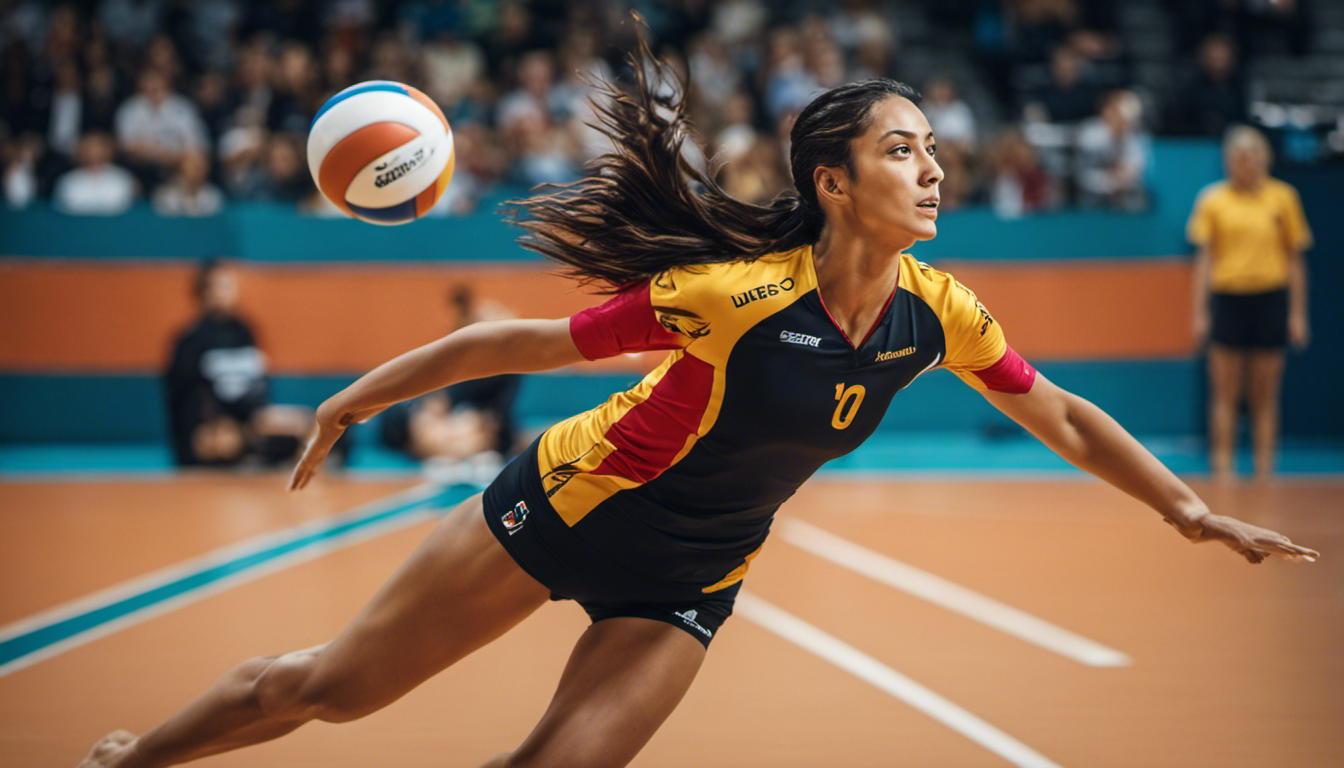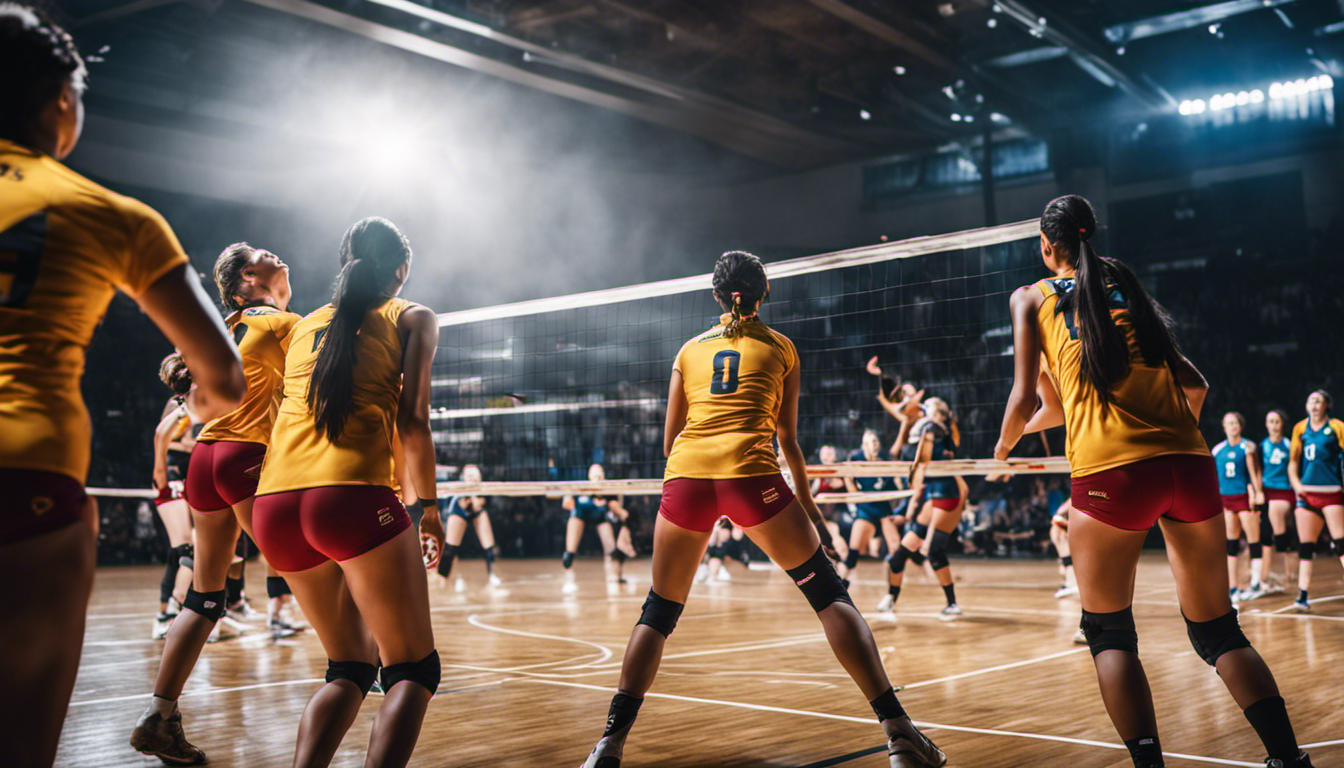As a volleyball player, I’ve always admired the skill and finesse of the libero. This defensive star has a crucial role in the game, specializing in dig and passing techniques that keep their team in control.
In this article, we’ll explore the responsibilities of a libero, from their role in serve receive to their ability to read opponents’ attacks. We’ll also discuss how liberos contribute to team communication and even find opportunities for offense.
Whether you’re a player or fan, understanding the importance of a libero is essential to appreciating the game at its highest level.
Key Takeaways
- The libero is responsible for excelling in defensive skills and being the primary passer in serve receive.
- The libero provides stability and confidence to teammates by anchoring the defense.
- The libero’s specialized defensive skills, such as reading the game and digging hard-driven spikes, are crucial for the team’s success.
- The libero’s role in serve receive, including proper technique and positioning, is crucial for consistently delivering accurate passes to the setter.
The Libero’s Position and Responsibilities

As the libero, my main responsibility is to excel in defensive skills and be the primary passer in serve receive. The libero’s impact on team dynamics cannot be overstated. By anchoring the defense, I provide a sense of stability and confidence to my teammates.
I am constantly communicating with them, directing their movements, and ensuring that everyone is in position to make plays. In transition plays, I play a crucial role as well. As soon as we gain possession of the ball, I quickly transition from defense to offense by making accurate passes to our setters or hitters. This helps us maintain a fast-paced and efficient attack, catching our opponents off guard.
Overall, as the libero, my contributions go far beyond individual statistics – I am an integral part of our team’s success both defensively and offensively.
Specialized Defensive Skills of a Libero

To excel as a libero, you must master specialized defensive skills that set you apart from other players on the volleyball court. As a libero, my role is crucial in keeping the ball off the ground and initiating successful attacks for my team.
Here are three essential specialized defensive techniques that every libero should focus on:
-
Reading the game: A great libero anticipates where the ball will be hit and adjusts their position accordingly. By studying opponents’ tendencies and analyzing their body language, I can make split-second decisions to be in the right place at the right time.
-
Digging: The ability to dig hard-driven spikes is a trademark skill of a libero. With quick reflexes, proper footwork, and solid platform technique, I can consistently make accurate digs to keep rallies alive.
-
Transitioning: Being involved in both defense and offense requires seamless transition skills. After making a dig or receiving a serve, I need to quickly reset myself for an offensive play by moving into position and providing reliable passing options for my teammates.
Mastering these specialized techniques allows me to fulfill my role as an effective libero while contributing significantly to our team’s success in matches.
Libero’s Role in Serve Receive

Being involved in both offense and defense, a libero’s ability to excel in serve receive is crucial for their team’s success. As a libero myself, I understand the importance of mastering serve receive techniques and honing my passing skills. By using proper technique and positioning, I am able to consistently deliver accurate passes to my setter, setting up our team for successful attacks. The table below highlights some essential serve receive techniques that every libero should master:
| Technique | Description | Importance |
|---|---|---|
| Platform Angle | Creating a flat platform with forearms to direct the ball accurately | Ensuring accurate pass placement |
| Footwork | Quick movements to get into position | Facilitating better ball control |
| Vision | Constantly scanning the court for potential threats | Anticipating and reacting effectively |
Reading the Opponent’s Attacks as a Libero
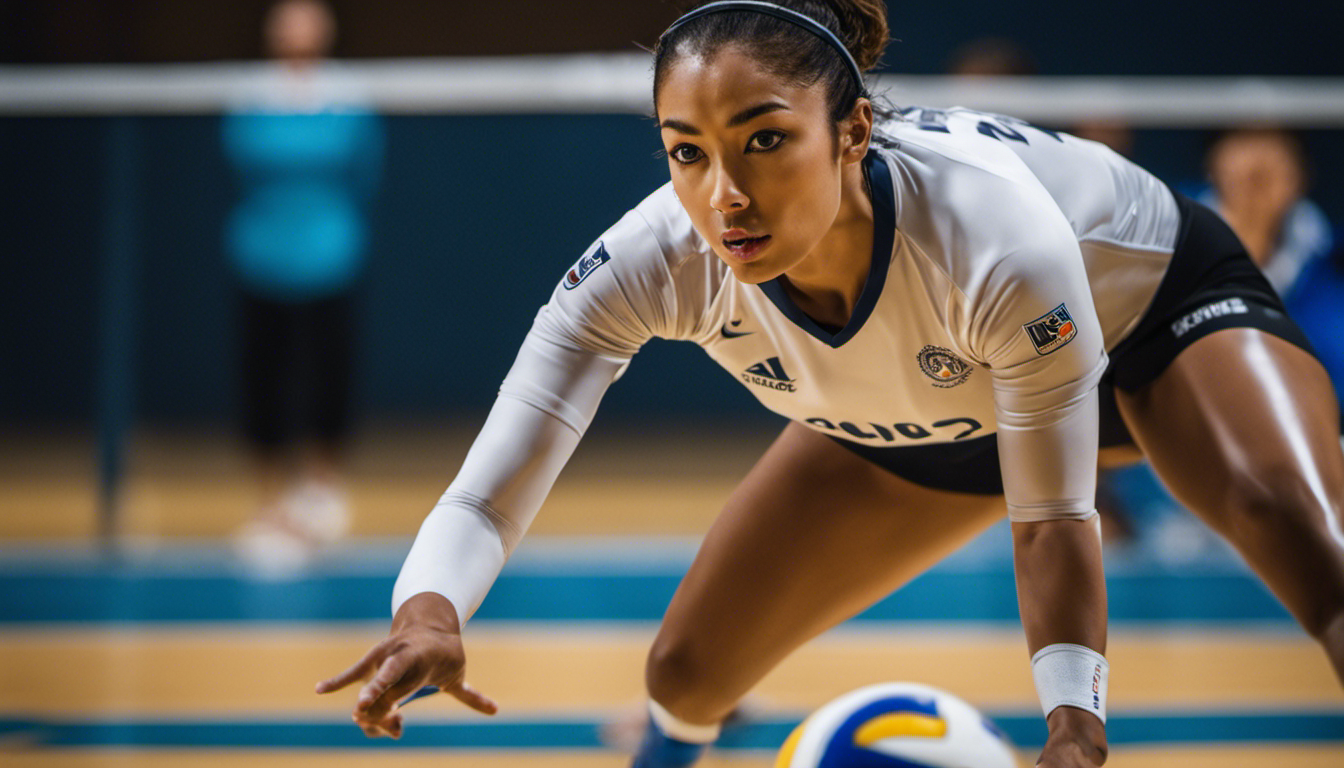
As a libero, one of the most crucial skills I’ve developed is analyzing attacker’s movements on the opposing team. By closely observing their footwork and body positioning, I can anticipate their strategies and adjust my defensive positioning accordingly.
This allows me to react quickly to offensive plays and make effective defensive moves that disrupt the opponent’s attack.
Analyzing Attacker’s Movements
Watch the attacker’s movements closely to anticipate their next move and position yourself effectively as a libero in volleyball. As a libero, it is crucial to analyze the attacker’s positioning and footwork to predict where they will hit the ball. Here are three key things to look for:
-
Approach angle: Pay attention to how the attacker approaches the ball. Are they coming from an angle or straight on? This can give you clues about their intended direction of attack.
-
Footwork speed: Notice how quickly or slowly the attacker moves their feet before making contact with the ball. Faster footwork often indicates a quicker attack, while slower footwork may suggest a softer shot.
-
Body alignment: Observe how the attacker aligns their body while preparing for an attack. Are they leaning forward or backward? This can indicate whether they are planning a spike or a tip over the net.
Anticipating Opponent’s Strategies
After analyzing the attacker’s movements, the next crucial aspect of my role as a libero is anticipating my opponent’s tactics. This involves studying their strategies and understanding their patterns to position myself defensively in the most effective way possible. By carefully observing their rotations and tendencies, I can anticipate where they are likely to hit or set the ball.
Anticipating opponent’s tactics allows me to react quickly and be in the right place at the right time to make a play. It requires intense focus and awareness on every point of the game. Whether it’s reading an attacker’s body language or spotting clues in their positioning, being able to anticipate what my opponents will do gives me a significant advantage.
Defensive positioning plays a key role in this process. By positioning myself strategically on the court based on my knowledge of my opponent’s tactics, I can increase my chances of making successful defensive plays. Being in the correct position enables me to dig hard-driven spikes or receive powerful serves with precision and control.
Overall, anticipating opponent’s tactics and mastering defensive positioning are essential skills for any libero aiming to excel in volleyball.
Reacting to Offensive Plays
React quickly to offensive plays by reading the attacker’s body language and adjusting your defensive positioning accordingly. Being able to anticipate the opponent’s moves is crucial in volleyball, especially for a libero like myself. Here are three key strategies I employ to ensure my defensive positioning is on point:
-
Stay focused: I constantly scan the court, observing both the ball and the attacker’s movements. This allows me to react swiftly and position myself in the optimal spot to receive or dig the ball.
-
Trust instincts: Experience has taught me that quick reactions come from trusting my instincts. By being alert and instinctual, I can make split-second decisions on where to move and how to position myself defensively.
-
Communicate with teammates: Effective communication is essential in any team sport, particularly when it comes to defensive positioning. By communicating with my teammates, we can coordinate our efforts and make necessary adjustments based on offensive plays unfolding before us.
Libero’s Contribution to Team Communication
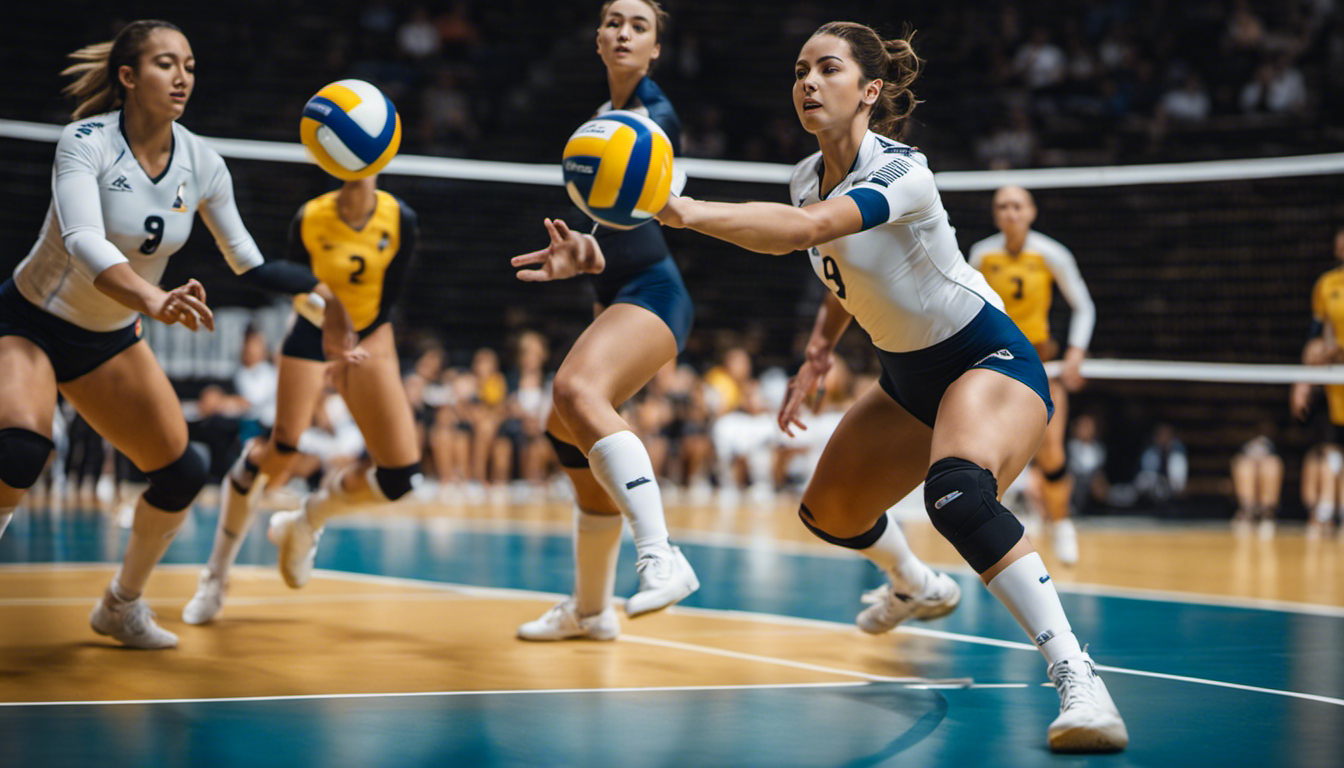
During a volleyball match, as a libero, you’re responsible for maintaining constant communication with your teammates. The libero’s impact on team communication cannot be overstated.
As the defensive specialist, I take charge of organizing and directing our defense. It is my duty to ensure that everyone is in the right position and aware of the opposing team’s strategies.
Through clear and concise instructions, I provide guidance to my teammates, helping them make split-second decisions on where to position themselves on the court.
My role as a libero requires strong leadership skills, as I need to effectively communicate with each player, motivating and encouraging them during intense moments.
Offensive Opportunities for a Libero
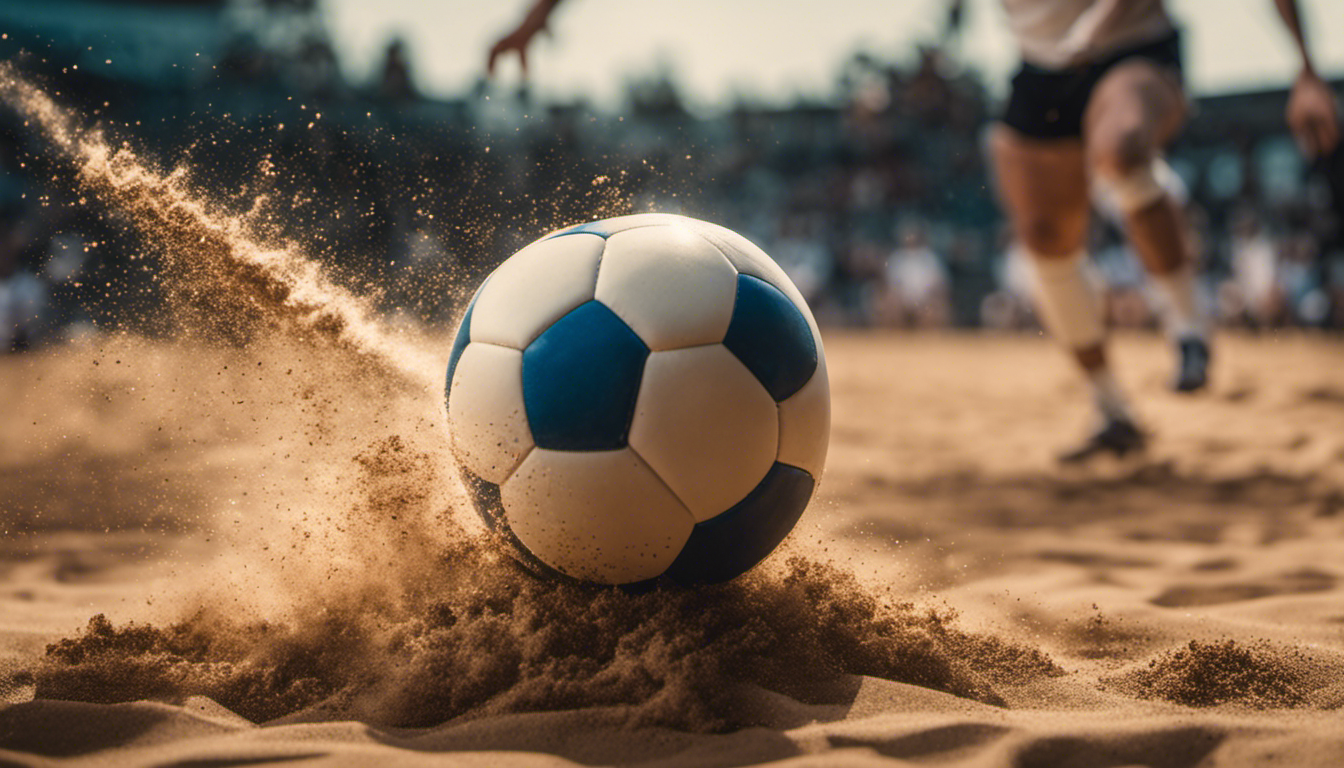
As a libero, there are various offensive opportunities that can enhance my contribution to the team. One key aspect is setting options for the team, allowing me to utilize my defensive skills to set up my teammates for successful attacks.
However, it is important to be aware of the limitations in attacking as a libero and find ways to overcome them through strategic positioning and communication with the rest of the team.
Setting Options for Libero
One of the setting options for a libero is to perform a quick set to the middle hitter. As a libero, I understand the impact my role has on team dynamics and strategies for maximizing my effectiveness.
Here are three strategies that can help maximize the libero’s impact:
-
Communication: The libero needs to communicate effectively with their teammates, providing accurate information about opposing hitters and potential attack angles.
-
Quick Sets: By performing a quick set to the middle hitter, the libero can catch the opposing defense off guard and create opportunities for scoring points.
-
Defensive Awareness: The libero must have excellent defensive awareness, reading plays and anticipating where the ball will go. This enables them to make quick passes or digs, keeping the ball in play and setting up their team for successful attacks.
Attacking Limitations for Libero
The libero’s ability to attack is limited due to certain restrictions in the rules of volleyball. As a libero, my primary role is to excel in defensive skills and support the team by receiving serves and making accurate passes.
However, there are times when I can utilize blocking techniques to contribute offensively. Although I may not be able to perform powerful spikes or kill shots like other players, I can still make smart plays by using tipping or roll shots over the net.
Additionally, I have learned how to overcome my height disadvantage by focusing on accuracy and strategic placement rather than relying solely on power. By utilizing these techniques and playing with intelligence, I can still contribute positively to my team’s offensive efforts as a libero.
Offensive Strategies for Libero
After discussing the limitations of attacking for a libero, let’s now explore some offensive strategies that can be employed to maximize their impact on the game. As a libero, there are several techniques you can utilize to create offensive options for yourself and your team.
-
Utilize the back-row attack: While not as powerful as an outside hitter’s attack, a well-executed back-row attack can catch opponents off guard and earn valuable points.
-
Master the dump shot: A cleverly executed dump shot can surprise the opposing team and lead to easy points. By disguising your intent and placing the ball strategically, you can exploit gaps in the defense.
-
Develop strong serving skills: As a libero, your serve is an opportunity to put pressure on the opposition and initiate offensive plays. Focus on improving your serving technique to consistently place serves in tough areas.
Training and Development for Liberos
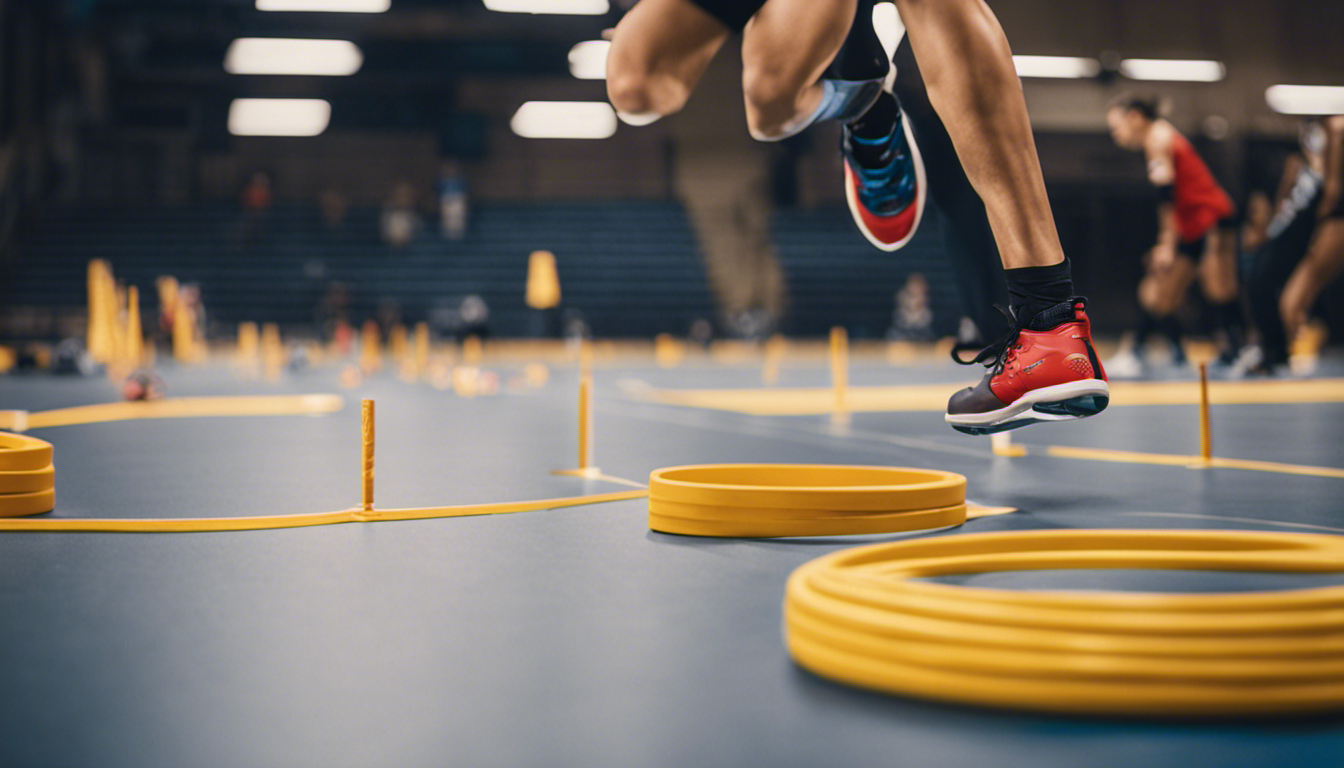
Liberos should focus on practicing their skills regularly in order to improve their performance on the court. As a libero myself, I understand the importance of both strength and conditioning as well as mental preparation. To excel in this position, it is crucial to develop physical endurance and agility. This can be achieved through exercises such as plyometrics, speed drills, and weight training targeting core muscles. Additionally, mental preparation plays a significant role in a libero’s success. Building confidence, maintaining focus, and staying composed under pressure are essential aspects of the game. Visualization techniques, meditation, and positive self-talk can help in improving mental toughness. By combining strength and conditioning with mental preparation strategies, liberos can enhance their overall performance and contribute effectively to their team’s success.
| Strength & Conditioning | Mental Preparation |
|---|---|
| Plyometrics | Visualization |
| Speed Drills | Meditation |
| Weight Training | Positive Self-Talk |
| Core Muscles | Focus |
Frequently Asked Questions
What Is the Average Height and Physical Build of a Libero?
On average, a libero is shorter and has a leaner build compared to other volleyball players. Height isn’t the only requirement though; speed, agility, and excellent defensive skills are also crucial.
How Long Does It Typically Take to Develop the Specialized Defensive Skills Required to Be a Libero?
It typically takes a considerable amount of time and effort to develop the specialized defensive skills required to excel as a libero. Training techniques focused on footwork are crucial in honing these abilities.
Can a Libero Also Serve the Ball During a Match?
Yes, a libero can serve the ball during a match. While their main role is defensive, they are allowed to serve. However, their serving abilities are often not as strong as other players due to their specialized position.
What Is the Most Challenging Aspect of Reading the Opponent’s Attacks for a Libero?
The most challenging aspect of reading the opponent’s attacks for a libero is anticipating where the ball will go. It requires quick reflexes, knowledge of defensive techniques, and using reading strategies to predict the direction and speed of the attack.
How Does a Libero Communicate With Their Teammates During a Match?
During a match, non-verbal communication is crucial for a libero. In the fast-paced and noisy environment of volleyball, I use hand signals, eye contact, and body language to effectively communicate with my teammates.
Conclusion
Being a libero in volleyball is an incredibly important and challenging role. The libero’s ability to excel defensively, read the opponent’s attacks, contribute to team communication, and even find offensive opportunities sets them apart as a defensive star.
Through specialized training and development, liberos are able to develop the skills necessary to thrive in this position. Their contributions to the team cannot be understated, as they play a crucial role in keeping rallies alive and setting up their teammates for success.
Liberos truly are the unsung heroes of the volleyball court.
